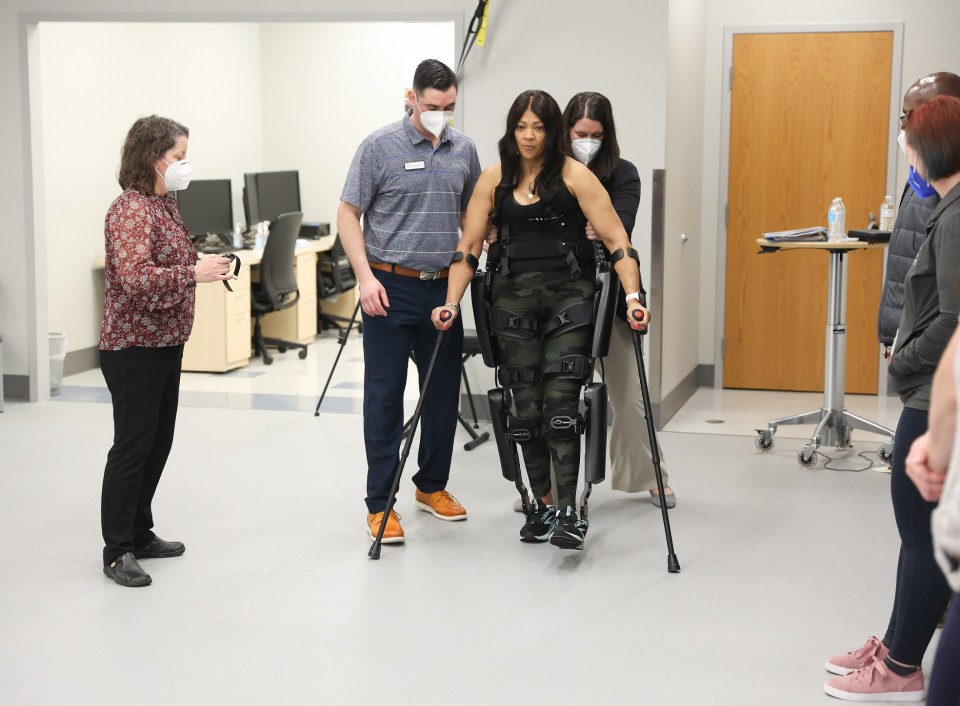Traumatic spinal cord injury (SCI) is a life-altering condition that affects thousands of individuals each year in the United States. There are approximately 18,000 reported cases of traumatic SCI in the United States each year. Out of those cases, the top causes of traumatic SCIs are motor vehicle accidents and falls (National Spinal Cord Injury Statistical Center).
Many with traumatic SCI will require a wheelchair for mobility, but the repeated movement to propel themselves forward can take its toll. Shoulder pain is a common complaint among those using a wheelchair, but there are preventative steps and treatment options that skilled clinicians can implement to reduce shoulder pain for their patients and even prevent it.
Prevalence of Shoulder Pain in Traumatic SCI
According to the Consortium for Spinal Cord Medicine, the two most common types of upper extremity injuries in those with spinal cord injuries are carpal tunnel syndrome and shoulder pain. On average, 80% of people who use a manual wheelchair for primary mobility report shoulder pain (Leving et al.) and an average of 80% of individuals with paraplegia or quadriplegia report shoulder pain (Alvarado et al.).
The pain tends to begin early in the inpatient rehabilitation stay, likely due to a diminished physical capacity during the weeks following their initial injury.
In addition, those with tetraplegia and limited range of motion in the upper body are likely to develop chronic shoulder pain (Eriks-Hoogland et al.).
While the percentage of shoulder pain in those with traumatic SCI has decreased in the past 50 years—likely due to lighter wheelchairs and better pain management options—it still occurs for many patients with traumatic SCIs.
Increased risk factors for shoulder pain and injury in those with traumatic SCI include:
- Obesity
- Increased age
- Female gender
Why Those with Traumatic SCI Develop Shoulder Pain
Shoulder pain after a traumatic SCI is caused by multiple factors. They include:
- Increase strain on the upper extremities.
- An increase in weightbearing activities.
- Increased reliance on the upper extremities for activities of daily living, or (ADLs).
- Abnormal push patterns on wheelchair handrims.
- Muscle tightness in the anterior shoulder muscles.
- Weakness in the posterior shoulder stabilizers.
The most prevalent diagnoses for shoulder pain in this patient population include impingement and rotator cuff tears. Impingement, a condition where the tendons of the rotator cuff are pinched, has been found to affect 75% of those with traumatic SCI; rotator cuff tears affect 65 to 70% of those with traumatic SCI (Mulroy et al.).
Individuals with traumatic SCI also have a high risk for overuse injuries and an increase in shoulder pressure during transfers that increases the risk of shoulder pain.
This pain can be debilitating for those with traumatic SCI, which can lead to the need for more assistance in ADLs, transfers, and potentially an inability to remain in their community.
Common Treatment Interventions for Shoulder Pain
Preventing upper extremity injuries is key to maintaining independence and quality of life.
The Consortium for Spinal Cord Medicine recommends minimizing repetitive upper extremity tasks, such as decreasing the amount of transfers per day, minimizing the number of strokes during wheelchair propulsion, and using power wheelchairs.
Decreasing the force required for the patient perform upper extremity tasks can help reduce and prevent shoulder pain. This could include:
- Educating the individual on weight management
- Using optimal wheelchair propulsion techniques and light and ultralightweight manual wheelchair options
- Minimizing shoulder positions that could cause injury, such as end range shoulder rotations. (Guidelines for the Preservation of Upper Limb Function Following SCI).
Incorporating flexibility and strength training simultaneously can also help in managing your patient’s shoulder pain. Stretching should be performed two to three times a week and should be centered around working on moving in pain-free ranges while addressing all muscle groups in the shoulder. Strengthening exercises should be performed two to three times a week and include eight to 10 exercises for eight to 12 repetitions each. Resistance should start light and increase over time.
Best Practice for Pressure Relief and Wheelchair Propulsion
Patients with SCI can use incorrect form to propel manual wheelchairs. Incorrect propulsion techniques and ill-fitting wheelchairs increase the risk for shoulder injury.
The muscles used most during manual wheelchair use are the biceps and triceps followed by the rotator cuff muscles in the shoulder. The supraspinatus muscle is located in the rotator cuff and is responsible for the highest power production. This increases the risk for injury due to its anatomical position and size (Leving et al.).
Instruct your patient to use smooth long strokes and ensure the upper extremity drifts downward, below the rim of their wheelchair (Guidelines for the Preservation of Upper Limb Function Following SCI). On average, active manual wheelchair individuals complete 2,700 rotations per day. This high rate combined with poor technique could contribute to an increase load in the shoulder muscles and also lead to overuse, tendonitis, RTC tears and impingement (Braaksma et al.).
Educating patients on optimal push techniques is vital to decreasing the number of rotations per day and decreasing contact on their handrims.
Wheelchair pushups may be one of the first interventions that comes to mind when training those with traumatic SCI on how to prevent pressure ulcers and wounds. However, wheelchair pushups could contribute to or lead to shoulder pain.
The clinical practice guidelines for pressure ulcer prevention following spinal cord injury recommend leaning forward or to the side at a 45 degree angle every 15 to 30 minutes. This may not be the safest or most appropriate technique for those in tilt-in-space wheelchairs. In this instance, have the patient tilt back to at least 65 degrees. For both, each position should be held for at least one minute and 50 seconds to facilitate blood flow and re-oxygenation to the tissue (Coggrave and Rose).
Explanation and Background of STOMPS Protocol
Strengthening and Optimal Movements for Painful Shoulders (STOMPS) is an evidence-based strengthening program that can decrease chronic shoulder pain in individuals with spinal cord injury.
The protocol consists of three phases:
- Stretching
- Warm-up
- Resistive shoulder exercise program
The resistive exercise phase includes shoulder elevation, external rotation, horizontal abduction and scapular retraction.
The resistive exercises can be performed in sitting or standing position. They should be completed slowly to target concentric and eccentric contractions and include a rest period of one to two minutes between each set. Based on STOMPS protocols, the patients should perform three sets of eight to 15 repetitions.
STOMPS recommends completing exercises targeting the RTC musculature first, then adding scapular and thoracic exercises as shoulder pain decreases (Mulroy et al.).
Finally, participants can use free weights, resistive bands or body weight to complete each exercise. STOMPS recommends completing at least 12 weeks of the recommended exercises for optimal effectiveness and pain reduction.
Studies conducted to determine the effectiveness of STOMPS showed a significant reduction in shoulder pain, improved quality of life and increased muscle strength after four weeks of completing the program. The benefits remained four weeks after the intervention period ended (Mulroy et al.).
Shoulder pain can contribute to a poor quality of life for many individuals living with traumatic SCI. Prevention of overuse injuries through the implementation of the STOMPS protocol, patient education, appropriate wheelchair seating, and optimal push patterns while using a manual wheelchair could be key in helping reduce shoulder pain in this patient population.
Resources
Guidelines for the Preservation of Upper Limb Function Following Spinal Cord Injury. Department of Physical Medicine and Rehabilitation/Trauma Rehabilitation Resources Program. (2021).
Leving MT et al. Changes in Propulsion Technique and Shoulder Complex Loading following Low-Intensity Wheelchair Practice in Novices. PLoS ONE. 2018.
Alvarado JRV, Felix ER, Gater DR. Upper Extremity Overuse Injuries and Obesity after Spinal Cord Injury. Top Spinal Cord Inj Rehabil. 2021.
National Spinal Cord Injury Statistical Center, Traumatic Spinal Cord Injury Facts and Figures at a Glance. Birmingham, AL: University of Alabama at Birmingham, 2023.
Mulroy SJ et al. Strengthening and Optimal Movements for Painful Shoulders (STOMPS) in Chronic Spinal Cord Injury: A Randomized Controlled Trial. Physical Therapy. 2011.
Braaksma J et al. Handrim Wheelchair Propulsion Technique in Individuals with Spinal Cord Injury with and without Shoulder Pain. American Journal of Physical Medicine and Rehabilitation. 2023.
Eriks-Hoogland I et al. Trajectories of Musculoskeletal Shoulder Pain after Spinal Cord Injury: Identification and Predictors. Journal of Spinal Cord Medicine. 2014.
Coggrave MJ and Rose LS. A Specialist Seating Assessment Clinic: Changing Pressure Relief Practices. Spinal Cord. 2003.
The content of this site is for informational purposes only and should not be taken as professional medical advice. Always seek the advice of your physician or other qualified healthcare provider with any questions you may have regarding any medical conditions or treatments.



